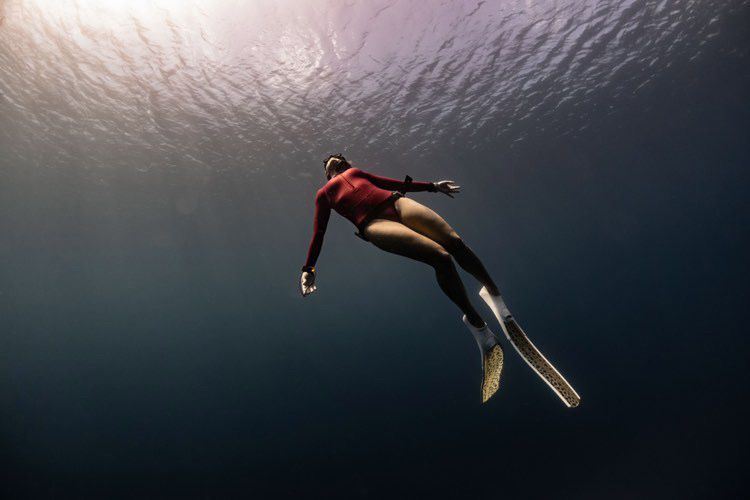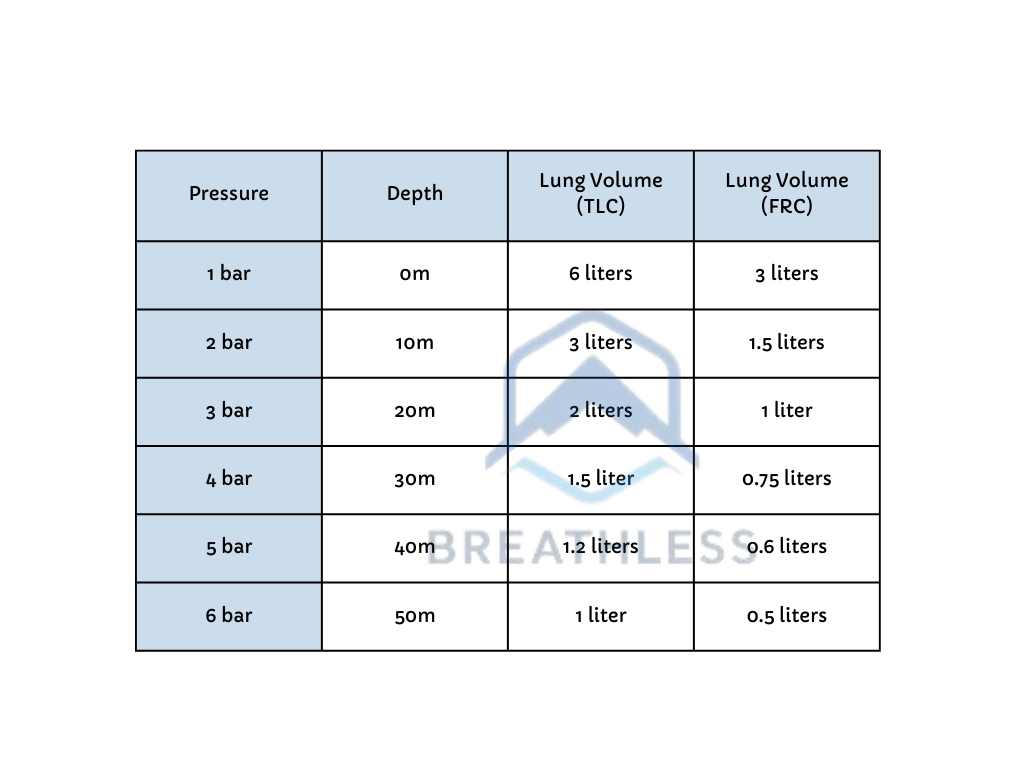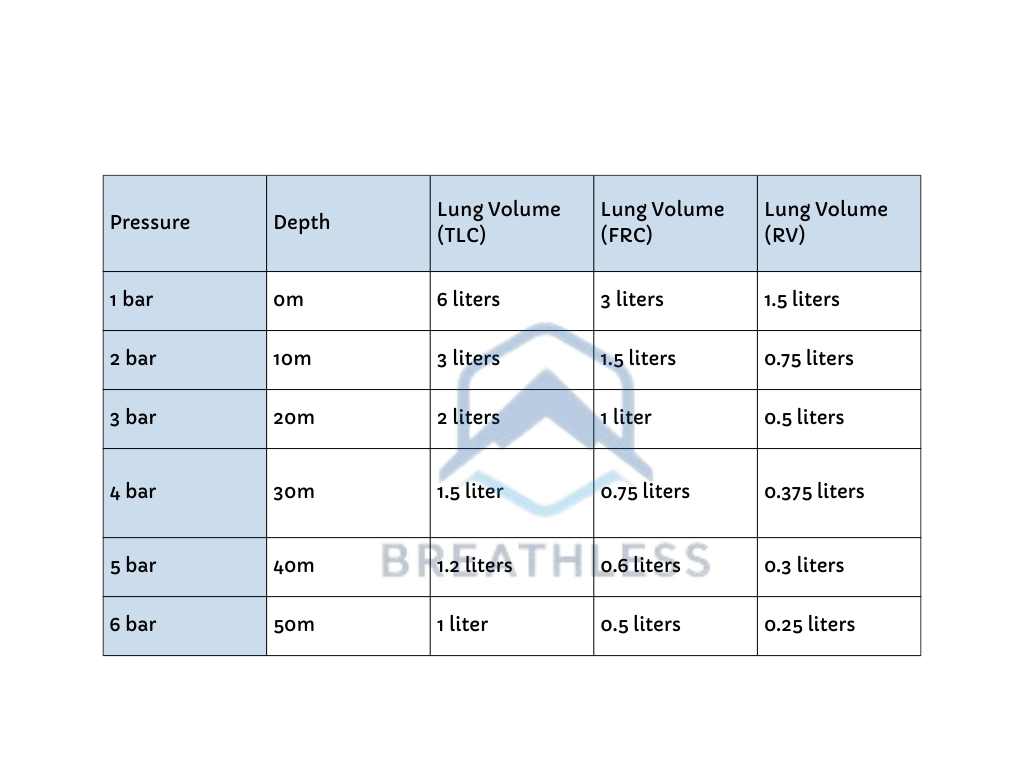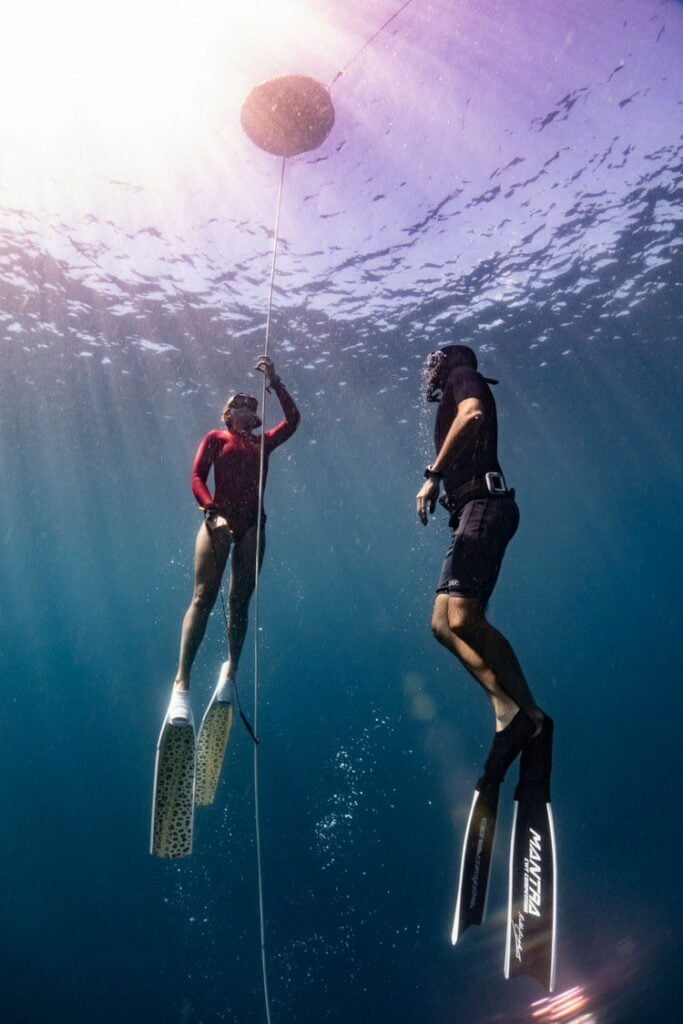Has anyone heard of FRC and RV training for freediving? These are two types of training methods for pressure adaptation in freediving and working on deep equalization techniques, where you can simulate great depths while diving without filling your lungs completely, as one would do in normal diving.
Freediving, the art of exploring the depths of the ocean with a single breath, has captivated adventurous souls worldwide. To excel in this beautiful and peaceful sport, freedivers continuously seek innovative training techniques that enhance their skills and underwater capabilities.
One such technique for depth training where you can’t find easy access to deep waters, or just for training without too much physical draining is FRC (Functional Residual Capacity) training. This technique has garnered attention for its potential benefits in preparing freedivers for deeper and more challenging dives.
FRC (Functional Residual Capacity) diving refers to diving with the lungs more or less half full, while TLC diving or full lung diving means diving with the lungs completely filled with air – which is the most common way to dive.
The volume of air in the lungs during these two types of diving can be compared as follows:
Therefore, in terms of lung volume, FRC diving involves approximately half the amount of air compared to full lung diving. It’s important to note that these volumes can vary based on an individual’s lung capacity and breathing techniques.
The primary reason for using FRC diving in freediving training is to simulate the effects of greater depths without the need to go as deep as in full lung diving. By diving on FRC, freedivers can challenge themselves and acclimatize to the physiological and mental demands of deeper dives while remaining at shallower depths for safety reasons.
Umberto Pelizzari, a renowned freediving pioneer, shares his invaluable perspective on FRC training and its impact on the world of freediving.
Umberto Pelizzari was born on August 28, 1965, in Busto Arsizio, Italy. From a young age, he was drawn to the enchanting allure of the ocean, igniting his passion for aquatic exploration. This innate connection with the sea laid the foundation for his remarkable journey into the world of freediving.
In the late 1980s and early 1990s, Pelizzari became a prominent figure in the freediving community, smashing world records and earning the title of “The Deepest Man on Earth.”
His exceptional skills and achievements brought freediving to the forefront, captivating the world’s attention and inspiring countless individuals to embrace the sport.
FRC, or Functional Residual Capacity, refers to the amount of air that remains in the lungs after a passive exhalation. FRC training involves diving with the lungs more or less half full, simulating the effects of greater depths while freediving. This technique allows divers to acclimatize to the challenges of deeper dives and optimize their breath-holding capacity.

As a seasoned freediver with extensive experience, Umberto Pelizzari acknowledges the significance of FRC training in the realm of freediving. His insights into the technique stem from years of personal exploration and experimentation, along with a deep understanding of the human body’s response to underwater pressure.
According to Pelizzari, FRC training serves as an invaluable tool for simulating the conditions of greater depths. By training with the lungs half full, freedivers experience a heightened awareness of their body’s physiological response to increased pressure, which aids in developing resilience and adaptability during deep dives.
In an interview, Pelizzari expressed his thoughts on FRC training: “FRC training plays an integral role in preparing freedivers for the challenges of the deep. By engaging in simulations of increased depth with the lungs half full, divers become attuned to their body’s needs and learn to optimize their breathing patterns. This form of training instills a sense of confidence and control, enabling divers to achieve remarkable feats beneath the surface.”
Pelizzari emphasizes the importance of gradual progression in FRC training to ensure safety and minimize the risk of overexertion. He advocates for a methodical approach to FRC training, stressing the significance of technique and understanding one’s limits.
As freedivers around the world continue to push the boundaries of human capability, techniques like FRC training, will play a pivotal role in enhancing performance and safety in the mesmerizing world of freediving.
I’ve engaged in quite a bit of FRC diving, and it’s both confronting and challenging. This method helps simulate depth when access to deeper training is limited. Though we can delve into mathematical equations to determine the exact depth we can simulate at each stage of an FRC dive, for simplicity’s sake, let’s consider that diving on FRC is akin to simulating a dive three times as deep as with full lungs.
The reasoning behind it is that, if at 1 bar (on the surface), the average male lung (that has 6 liters of air), at 10 meters, according to Boyle’s law, it will have 3 liters, and at 6 bar, down at 50 meters of depth, that lung will have 1 liter of air.
When you are diving on FRC, you will start with 3 liters of air (half lung full) on the surface, and at 20 meters, that will half into 1 liters of air.
Therefore, dive on full lugs to 50 meters, will be equivalent on the body to a 20 meter dive on FRC. The table below explains this relationship:

At the outset, engaging in FRC training might feel challenging, particularly for the mind. We are accustomed to diving with fully inflated lungs, aiming to secure abundant oxygen for a comfortable experience. However, transitioning to FRC involves a slight exhale, and our minds can’t help but play tricks on us, anticipating the need for air even before it arises. It’s essential to remember that FRC dives are relatively brief, and it’s easy to overlook that we still possess half a lungful of air.
Personally, I don’t know if you can relate, but in my experience, with each dive, there’s a moment when my mind resists, urging me to turn back. The instant I start thinking, “Oh no, I’m running out of air,” I catch myself and recognize this self-doubt that arises every single time. During every dive, that thought inevitably emerges, tempting me to stop and retreat, but I’ve also learned that if I push on for just five to ten more seconds, that feeling will subside. In FRC diving, that sensation intensifies and appears sooner. Thankfully, for training purposes, we don’t have to venture as deep as we would with a full lung dive, allowing us to remain comfortably close to the surface with our safety diver or buddy within reach.
Just when I thought FRC was challenging enough, I came across the concept of RV diving. RV diving means exhaling on an empty lung, not just a big exhale. Literally, trying to squeeze out every last bit of air from your lungs before descending – and not squeeze your lungs in the process.
So, have you ever heard of RV freedive training? It’s a fascinating technique that’s been gaining attention in the freediving community. RV stands for “Residual Volume,” and in this type of training, you exhale on an empty lung, squeezing out every last bit of air before descending into the depths.
The concept behind RV training is to simulate the effects of greater pressure at shallower depths. By starting the dive on an empty lung, you feel the pressure in your chest right from the beginning, and the challenge to equalize becomes more intense. It’s like a full-on underwater mental chess game, testing your mental fortitude and breath-holding skills to the max.
Some enthusiasts believe that RV training is even safer than traditional FRC (Functional Residual Capacity) training, as it induces physiological changes, such as the blood shift, that protect the lungs more rapidly. Additionally, with RV, you are going shallower compared to FRC, which means you experience the pressure of depth even earlier.
Engaging in RV freedive training requires careful consideration and proper instruction to ensure safety. It’s not something you want to jump into without understanding the technique and its potential risks. Many experienced freedivers have found RV training to be an excellent tool for improving depth and mental skills.
So, if you’re up for a challenge and ready to take your freediving to the next level, RV training might just be the exhilarating adventure you’ve been seeking! Remember to study the technique carefully and prioritize safety as you explore the wonders of the underwater world on a single breath.
As freedivers constantly seek to push their limits, they delve into various training methods to enhance their skills. Among these techniques, RV training, or Residual Volume training, has gained attention in recent years. Aharon Solomons, a distinguished freediving expert, offers a unique perspective on RV training, shedding light on its benefits and impact on the freediving community.
Aharon Solomons believes that RV (Residual Volume) diving is safer than FRC (Functional Residual Capacity) diving for several reasons, based on his experiences and knowledge in the freediving community.
Aharon Solomons is a seasoned freediving instructor and athlete with a wealth of experience in the world of underwater exploration. Born in Israel, his profound connection with the sea began at an early age. Growing up near the Mediterranean coast, Aharon spent countless hours exploring the underwater world, igniting his passion for freediving.
Fascinated by the beauty and mysteries of the ocean, Aharon embarked on a journey to master the art of freediving. He honed his skills under the guidance of renowned instructors and explored the depths of various seas and oceans around the globe. His dedication and natural talent quickly made him a prominent figure in the international freediving community.
Over the years, Aharon Solomons has not only achieved remarkable depths but has also become an acclaimed instructor, sharing his knowledge and expertise with aspiring freedivers worldwide and is the biggest enthusiast on RV Freediving training. His teaching philosophy centers around safety, technique, and the importance of mindfulness in deep dives.
RV training involves exhaling on an empty lung, squeezing out every last bit of air before descending. The method is believed to be safer than traditional FRC (Functional Residual Capacity) training, as it induces physiological changes that protect the lungs more rapidly. Additionally, RV training simulates pressure earlier, allowing freedivers to go shallower while still experiencing the challenges associated with depth.
The consensum is that RV is somewhere around 20-25% of your full lung volume. So let’s say that the RV for the average male diver is 1.5 liters (given that the full lung volume is 6 liters). Following this logic, on the table below, you can see how the pressure in the body is simulated by using RV, and how much shallower we need to dive using RV to simulate deep dives:

We don’t need to dive any deeper than ten meters in RV to simulate a dive even deeper than 60 meters. By examining the table, you can also observe how an RV dive to 10 meters, would equate in the body, to an FRC dive to 30 meters. equiate
Having said that, it is a training style that should be done very gradually and mindfully. Solomons advises not to go any further than three to four meters on this type of dive, and never exceed the ten meter mark.
For Aharon Solomons, RV training represents a revolutionary approach to enhance freediving skills. Having extensively practiced and experimented with this technique, he acknowledges its unparalleled impact on the mind-body connection. In an interview, Aharon shared his thoughts on RV training: “RV training is a game-changer in the world of freediving. It challenges not only the body but also the mind in ways that conventional training methods cannot. By pushing ourselves to explore the limits of our residual lung volume, we gain a deeper understanding of our physical and mental capabilities. The experience of diving with empty lungs forces us to confront our fears and develop unwavering self-confidence.”
According to Aharon, the mental aspect of RV training is what sets it apart. It serves as an underwater mental chess game, where freedivers must master control over their thoughts and emotions to achieve successful dives. The training builds resilience, allowing divers to combat self-doubt and embrace discomfort with every breath.
As the sport of freediving continues to evolve, innovative training techniques like RV training, championed by experts like Aharon Solomons, push the boundaries of what is possible in the deep blue. Embracing the challenges of RV training not only refines one’s freediving skills but also instills a profound appreciation for the incredible power and beauty of the underwater world.
I’ve been diving on this and boy… It is serious stuff! If I thought FRC diving is mentally demanding, this takes it to another level; this time, we don’t even have that half lung of air. It’s like navigating a treacherous maze in the depths of the mind
As soon as you submerge on an RV dive, immediately, you feel the pressure in your chest and equalizing becomes more challenging. It is an amazing tool for training depth and mental skills too. I’ve found that training on FRC and RV has given me a lot more to work with, and a lot more confidence when attempting deeper dives. It’s giving my lungs the flexibility in the way they need it and it gives my body that adaptation it craves from a shallower and safer depth.
The insights you can gain about how to troubleshoot at great depths, having the safety of the buoy at arms reach is amazing. You can really take a moment to stop, and go very slowly, feeling each sensation: the vacuum in the throat, the rolling forwards of the shoulders, the lack of air left in your mouth and how to use the remainder to compensate for the pressure in the ears. And of course, letting the body adapt to be able to pursue depths at any given time.
If you’re considering attempting these kinds of dives, please study them carefully and prioritize safety. Simulating great depths requires careful consideration to protect the body. It’s important to point out that even though big freediving figures such as Umberto Pelizzari and Aharon Solomons believe FRC and RV diving to be safer, any form of freediving carries inherent risks, and proper training, technique, and safety protocols should always be followed.
Engaging in RV or FRC diving should only be done under the guidance of experienced instructors and with a thorough understanding of the potential risks involved. As with any extreme sport, safety is paramount in freediving, and divers should prioritize their well-being above all else.
Learn all about FRC and RV in our Advanced Freediving Course.


Experiences, expeditions and education to unlock your potential, open your heart and let your breath set you free.










Stay up to date with the latest information on our activity and performance.